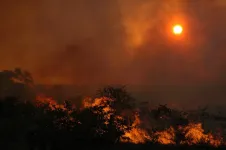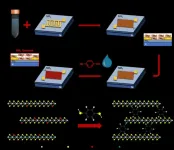Forests' long-term capacity to store carbon is dropping in regions with extreme annual fires
2021-02-25
(Press-News.org) More intense and frequent fires are reducing the size of tree communities in many regions of the world.
Slower-growing tree species are better at surviving fires, but these may capture less atmospheric carbon and reduce nutrient availability in the soil.
Not all regions are suitable for planting trees to tackle climate change; schemes must consider local wildfire frequency, vegetation cover and climate, and how these might change over time.
Researchers have analysed decades' worth of data on the impact of repeated fires on ecosystems across the world. Their results, published today in the journal Nature Ecology and Evolution, show that repeated fires are driving long-term changes to tree communities and reducing their population sizes.
Savannah ecosystems, and regions with extreme wet or dry seasons were found to be the most sensitive to changes in fire frequency. Trees in regions with moderate climate are more resistant. Repeated fires also cause less damage to tree species with protective traits like thicker bark.
These effects only emerge over the course of several decades: the effect of a single fire is very different from repeated burning over time. The study found that after 50 years, regions with the most extreme annual fires had 72% lower wood area - a surrogate for biomass - with 63% fewer individual trees than in regions that never burned. Such changes to the tree community can reduce the forest's long-term ability to store carbon, but may buffer the effect of future fires.
"Planting trees in areas where trees grow rapidly is widely promoted as a way to mitigate climate change. But to be sustainable, plans must consider the possibility of changes in fire frequency and intensity over the longer term," said Dr Adam Pellegrini in the University of Cambridge's Department of Plant Sciences, first author of the paper.
He added: "Our study shows that although wetter regions are better for tree growth, they're also more vulnerable to fire. That will influence the areas we should manage to try and mitigate climate change."
Past studies have found that frequent fires reduce levels of nutrients - including nitrogen - in the soil. The new study demonstrates that this can favour slower-growing tree species that have adaptations to help them survive with less nutrients. But these tree species also slow down nutrient cycling in the soil - they hold onto what they have. This can limit the recovery of the forest as a whole by reducing the nutrients available for plant growth after an intense fire.
Wildfires are playing an increasingly important role in global carbon emissions. Fire burns five percent of the Earth's surface every year, releasing carbon dioxide into the atmosphere equivalent to 20% of our annual fossil fuel emissions.
In the past, the majority of carbon released by wildfires was recaptured as ecosystems regenerated. But the more frequent fires of recent years, driven by changes in climate and land use, don't always allow time for this.
"As fire frequency and intensity increases because of climate change, the structure and functioning of forest ecosystems are going to change in so many ways because of changes in tree composition," said Pellegrini.
He added: "More fire-tolerant tree species are generally slower growing, reducing the productivity of the forest. As climate change causes wildfires to become more intense and droughts more severe, it could hamper the ability of forests to recover - reducing their capacity for carbon storage."
INFORMATION:
The study is the largest of its type ever to be undertaken. Researchers analysed data from a global network of 374 plots distributed across 29 sites throughout four continents, where plots have experienced different fire frequencies and intensities for multiple decades.
The network spans a broad geographical range of ecosystems from African and Australian savannahs and grasslands, to forests in Europe and North America. These are all ecosystems that experience natural burning, or would do if humans weren't suppressing fires.
[Attachments] See images for this press release:

ELSE PRESS RELEASES FROM THIS DATE:
2021-02-25
Until recently, scientists believed that the primary cilium - an antenna-like structure found on the surface of most human cells - was largely vestigial and had little bearing on the day-to-day lives of human beings. But more recently, a relatively small number of people have been found to have rare genetic disorders affecting the cilium, characterized by a number of health problems, including common conditions like diabetes, kidney failure, and liver fibrosis. Now, an analysis of genes involved in the function of the cilium found that the same genes causing its rare diseases might ...
2021-02-25
What The Study Did: Researchers in this observational study of more than 10,000 U.S. Air Force basic trainees examined whether symptoms and laboratory results on the first day of COVID-19 diagnosis are associated with development of a case cluster in a congregate setting.
Authors: Joseph E. Marcus, M.D., of the Brooke Army Medical Center at Joint Base San Antonio Fort Sam Houston, Texas, is the corresponding author.
To access the embargoed study: Visit our For The Media website at this link https://media.jamanetwork.com/
(doi:10.1001/jamanetworkopen.2021.0202)
Editor's Note: Please see the article for additional information, including other authors, author contributions and affiliations, conflict of interest and financial disclosures, and funding ...
2021-02-25
What The Study Did: This research letter describes the various otolaryngologic manifestations in patients 18 years or younger with pediatric inflammatory multisystem syndrome temporally associated with SARS-CoV-2.
Authors: Ryan C. T. Cheong, B.Sc.(Hons), M.B.B.S., of the Great Ormond Street Hospital for Children NHS Trust in London, United Kingdom, is the corresponding author.
To access the embargoed study: Visit our For The Media website at this link https://media.jamanetwork.com/
(doi:10.1001/jamaoto.2020.5698)
Editor's Note: The article includes conflict of interest and funding/support disclosures. Please see the article for additional information, including other authors, author contributions and affiliations, conflict of interest ...
2021-02-25
What The Study Did: Data from five studies were pooled to investigate whether cognitive decline among older U.S. adults varied by sex.
Authors: Deborah A. Levine, M.D., M.P.H., of the University of Michigan in Ann Arbor, is the corresponding author.
To access the embargoed study: Visit our For The Media website at this link https://media.jamanetwork.com/
(doi:10.1001/jamanetworkopen.2021.0169)
Editor's Note: The article includes conflicts of interest and funding/support disclosures. Please see the article for additional information, including other authors, author contributions and affiliations, conflict of interest and financial ...
2021-02-25
What The Study Did: Researchers looked at whether state legalization of recreational cannabis was associated with changes in use by women before, during and after pregnancy.
Authors: Kara R. Skelton, Ph.D., of the Johns Hopkins Bloomberg School of Public Health in Baltimore, is the corresponding author.
To access the embargoed study: Visit our For The Media website at this link https://media.jamanetwork.com/
(doi:10.1001/jamanetworkopen.2021.0138)
Editor's Note: Please see the article for additional information, including other authors, author contributions and affiliations, conflict of interest and financial disclosures, ...
2021-02-25
Antarctica's northern George VI Ice Shelf experienced record melting during the 2019-2020 summer season compared to 31 previous summers of dramatically lower melt, a University of Colorado Boulder-led study found. The extreme melt coincided with record-setting stretches when local surface air temperatures were at or above the freezing point.
"During the 2019-2020 austral summer, we observed the most widespread melt and greatest total number of melt days of any season for the northern George VI Ice Shelf," said CIRES Research Scientist Alison Banwell, lead author of the study published in The Cryosphere.
Banwell and her co-authors--scientists at ...
2021-02-25
Nanoengineers at the University of California San Diego have discovered new fundamental insights for developing lithium metal batteries that perform well at ultra-low temperatures; mainly, that the weaker the electrolyte holds on to lithium ions, the better. By using such a weakly binding electrolyte, the researchers developed a lithium metal battery that can be repeatedly recharged at temperatures as low as -60 degrees Celsius--a first in the field.
Researchers report their work in a paper published Feb. 25 in Nature Energy.
In tests, the proof-of-concept battery retained 84% and 76% of its capacity over 50 cycles at -40 and -60 degrees Celsius, respectively. Such performance is unprecedented, researchers ...
2021-02-25
The exfoliation of graphite into graphene layers inspired the investigation of thousands of layered materials: amongst them transition metal dichalcogenides (TMDs). These semiconductors can be used to make conductive inks to manufacture printed electronic and optoelectronic devices. However, defects in their structure may hinder their performance. Now, Graphene Flagship researchers have overcome these hurdles by introducing 'molecular bridges'- small molecules that interconnect the TMD flakes, thereby boosting the conductivity and overall performance.
The results, published in Nature Nanotechnology, come from a multidisciplinary collaboration between Graphene Flagship partners the University of Strasbourg and CNRS, France, AMBER and Trinity College Dublin, Ireland, ...
2021-02-25
Human rights law can provide a transparent and fair framework for vaccine allocations, researchers suggest.
- All countries face the ethical challenge of how to allocate limited supplies of safe, effective COVID-19 vaccines
- Researchers say that governments should look to human rights principles and commitments to help them decide who should get priority for the first available doses of COVID-19 vaccine.
- A human rights approach would include social vulnerability alongside medical vulnerability in decision-making because health is affected by social factors.
- National vaccine roll-outs should take account of these overlapping vulnerabilities
As Governments around the world wrestle with the question of designing ...
2021-02-25
Future fully autonomous vehicles will rely on sensors to operate, one type of these sensors is LiDAR
LiDAR sensor's effectiveness in detecting objects at a distance in heavy rain decreases, researchers from WMG, University of Warwick have found
Researchers used the WMG 3xD simulator to test the sensor detection of objects in rain, simulating real world roads and weather
High level autonomous vehicles (AVs) are promised by Original Equipment Manufacturers (OEMs) and technology companies to improve road safety as well as bringing economical and societal benefits to us all.
All high-level AVs rely heavily on sensors, and in the paper, 'Realistic LiDAR with Noise Model for Real-Tim Testing of Automated Vehicles in ...
LAST 30 PRESS RELEASES:
[Press-News.org] Forests' long-term capacity to store carbon is dropping in regions with extreme annual fires



